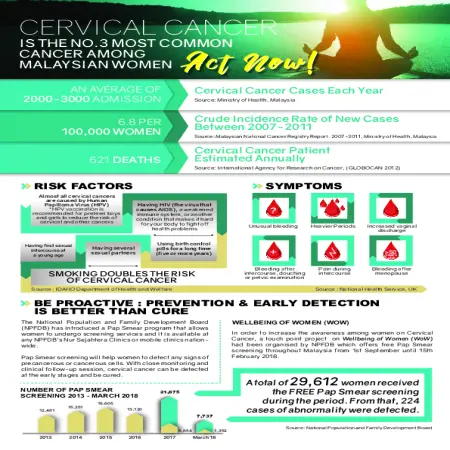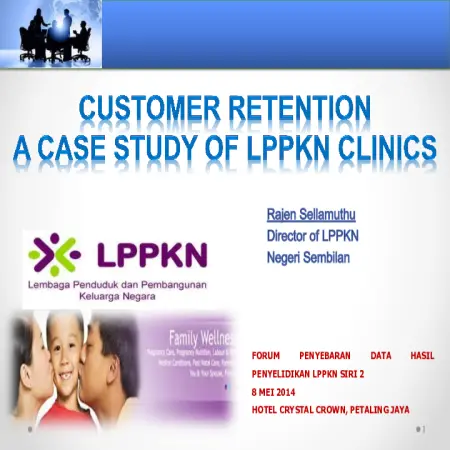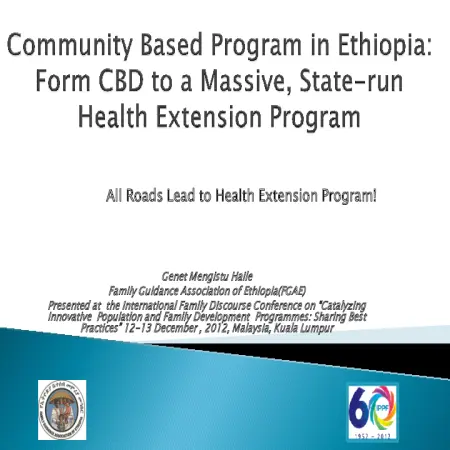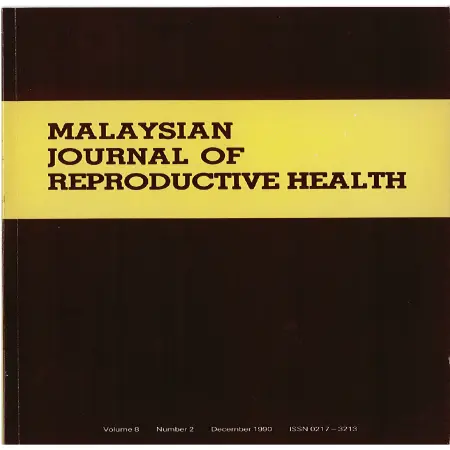TOPICS
Results for Topics : "Health"
2023 (1)
|
|
Cepat Tahu, Cepat Tindak
Item Type: Video
Editor:
Year: 00/01/2023
Abstract: Educational video regarding the importance of undergoing a mammogram test which is an examination to detect the early stages of breast cancer while the HPV DNA test is a test to detect the Human Papillomavirus (HPV) that is infected through sexual contact. Cervical cancer is cancer at the base of the uterus caused by HPV.
|
|
|
|
2018 (1)
|
|
Cervical cancer
Item Type: Infographic
Editor:
Year: 00/05/2018
Abstract: This infographic describes information about cervical cancer. Cervical cancer is the no.3 most common cancer among Malaysian women. Almost all cervical cancers are caused by Human Papilloma Virus (HPV). The symptoms such as unusual bleeding, heavier periods and bleeding after menopause.
|
|
|
|
2014 (1)
|
|
Customer retention: a case study of LPPKN clinical services
Item Type: Conference or Workshop Item
Editor:
Year: 00/00/2014
Abstract: This is a descriptive study intended to identify the main factors which contribute to the customer retention among the “Clinical Clients” of National Population and Family Development Board or LPPKN. The study focused on three variables to check on the level of influence, affect and effect to the process of customer retention. Those variables are service branding, perceived value and service quality. The study also covered the impact and influence of the demographic element to the service branding, perceived value and service quality in the process of customer retention. This study was conducted at the LPPKN Clinics in Klang Valley and Seremban. Understanding and fulfilling the customers need will contribute to retaining existing customers and reduce the customer switching intentions. The research findings show there is a positive relationship between perceived value and service quality with customer retention. Nevertheless relationship between service branding and customer retention is not supported for the LPPKN clinical setting. Analysis on the demographic factor showed that, it has a significant influence in regard to service branding, perceived value, services quality and customer retention. The output of the study will be helpful to managers and marketers of the clinical service to understand the customer needs, priority and expectations. Furthermore the findings of the research will enable the managers and policy makers to take necessary actions in their marketing and operational planning to stay competitive and maintain a stable income for a long term. This study will also help LPPKN Clinics to improve service quality, increase number of clinical clients, facilitate the process of customer retention and in long term improve financial performance.
|
|
|
|
2012 (1)
|
|
Community based program in Ethiopia: from CBD to massive, state-run health extension program
Item Type: Conference or Workshop Item
Editor:
Year: 00/00/2012
Abstract: The Family Guidance Association of Ethiopia (FGAE) pioneered a Community-based FP Distribution [CBD] program in Ethiopia in 1991. The CBD agents were selected by the community members through prior set selection criteria including interest and willingness to volunteer for community work and sufficient knowledge about the socio-economic and cultural context of the community. The CBD program was very widely replicated by many other institutions as a low cost, effective strategy to increase access to modern contraceptive services in under-served communities. Considering the challenges related to distance and access to fixed health facilities among women with high unmet needs and the lessons drawn from project based success stories of the CBD programs, the government of Ethiopia initiated the Health Extension Program (HEP) in 2003 to accelerate utilization of primary health care services in rural communities. The HEP is implemented by trained health extension workers or practitioners at the community level with strong focus on health promotion and disease prevention and empowering community members to make decisions and take actions on their own health. The Health Extension Workers (HEW) were recruited from the community among those who completed high school and trained for one year. Currently, two female HEWs are assigned at each kebele (the lowest administrative unit) and to implement a package of 16 primary health care services including FP and maternal health. A total of about 35,000 rural HEWs and 4,800 urban Health Extension Professionals [Graduate Nurses] are deployed by MoH as government employees throughout the country. The program has created a better opportunity, particularly for rural women and young people to access health services including FP/RH.
|
|
|
|
2011 (1)
|
|
Cytotoxicity and expression profiles of apoptosis gene related in human cervical cancer (HeLa) cell lines in response to Newcastle disease virus (NDV) strains AF2240 And V4-UPM
Item Type: Thesis
Editor:
Year: 01/01/2011
Abstract: In this study the cytotoxicity and expression profiles of apoptosis gene related in human cervical cancer (HeLa) cell lines in response to Newcastle disease virus (NDV) strains AF2240 and V4-UPM were studied. NDV is a strain of avian paramyxovirus. NDV has been classified into the order Mononegavirales, family Paramyxoviridae, subfamily Paramyxovirinae and genus Rubulavirus. NDV caused severe economic losses in the poultry industry worldwide. Several local strains of Newcastle disease virus were reported to induce cytolysis to the cancerous cell lines. Strain AF2240 is a heat resistant viscerotropic velogenic NDV and strain V4-UPM is a heat resistant lentogenic which has significant higher thermostabilities of infectivity and haemagglutination were reported cytolysis leukemic cells in vitro and has shown in vivo anti leukemic agents . In this study the cytotoxicity effects of strains of NDV AF2240 and V4-UPM towards HeLa cell were determined by using standard microtetrazolium assay (MTT). Cytotoxicity dose 50% (CD50) cells treated with different titre of NDV as haemagglutination units (HAU) as compared to the untreated cells was estimated at 72 hours post-infection. The CD50 values obtained were 0.95 HAU and 1.0 HAU for strains AF2240 and V4-UPM, respectively. No cytolytic effect was noted towards normal cells (3T3) was observed. Both strains were also observed to inhibit HeLa cell proliferation. Morphological observations also have been done under inverted light and fluorescence microscopes. Under the inverted light microscope, the HeLa cells treated with both strains showed apoptotic features such as cell shrinkage, cell blebbing and formation of apoptotic bodies. Morphological features of apoptosis were also observed by using the AO/PI staining method under the fluorescence microscope. The AO/PI staining demonstrated the occurrence of apoptosis which was characterised mainly by chromatin condensation, nuclear shrinkage and formation of apoptotic bodies. Evidently, both strains AF2240 and V4-UPM used in the study were found to induce cells towards apoptosis rather than necrosis. NDV strain AF2240 and strain V4-UPM was also caused genotoxic in HeLa cells after two hours treatment with CD10 and CD25 values by alkaline comet assay. Results showed that HeLa cells treated with NDV strains AF2240, V4-UPM and hydrogen peroxide gave different distribution of scores. The HeLa cells treated with hydrogen peroxide as a positive control gave more percentage at score 2, 3 and 4 for both cytotoxicity values compared to the HeLa cells treated with NDV for both strains. Observation in this study has proved the genotoxic potential of the NDV strains AF2240 and V4-UPM to induce DNA damage on HeLa cells as early as two hours following treatment at very low cytotoxicity dose (CD10 and CD25) values. Meanwhile, the cell cycle analyses of HeLa cells treated with local strains of NDV AF2240 or V4-UPM did not induce cell cycle arrest in any specific phase. Sub-G1 phase (apoptosis peak) was found in both treated cells with a very high percentage compared to untreated cells with a small percentage. The results indicate that, the percentages of apoptosis were significantly increased (p≤0.05) in the time-dependent manner in both NDV strains treated HeLa cells. The molecular mechanisms of apoptosis may depend on the NDV strain and cell type. Six apoptosis genes were selected in this study namely Casp8, TNF-α, Bcl2 and TRAIL which focused on extrinsic pathway of apoptosis, while the gene Bax was used as an indicator for intrinsic pathway triggered by cellular stress. Lastly Myc, oncogene was used as an indicator for cell growth. From this study, NDV strain AF2240 was identified as a highly induced death receptor pathway due to the upregulation of TNF gene and the downregulation of Bax gene. Whereas NDV strain V4-UPM triggered both pathways but through the extrinsic pathway due to the very high expression of the TNF gene. The TNF gene was highly expressed due to its location and function as a stimulator of the death receptor pathway. The Casp8 gene was activated and expressed in order to enter the execution-phase of cell death. The Bcl-2 gene was continuously observed because of its function as an apoptosis regulator. Surprisingly, no expression was detected by the TRAIL gene. NDV strain AF2240 was more effective than NDV strain V4-UPM as an apoptosis inducer. These gene expression results showed that the apoptosis occurred and lead to cell death.
|
|
|
|
1990 (1)
|
|
Clinical evaluation of Buserelin, a GnRH analogue in the management of moderate to severe pelvic endometriosis
Item Type: Article
Editor:
Year: 00/12/1990
Abstract: A local study, a part of a multinasional and multicenter study on the efficacy and safety of Buserelin was carried out for the treatment of pelvic endometriosis using a standard protocol. 20 women diagnosed to have moderate to severe endometriosis by laparoscopy were recruited. The women were given 900 micrograms Buserelin acetate daily by intranasal spray for a fixed period of 6 months. Baseline hormonal and biochemical parameters were taken prior to treatment and the parameters were repeated during each follow-up at weekly and monthly intervals. In addition, changes in symptoms were monitored. A second look laparoscopy was performed at completion of therapy and patients were followed up for a further 6 months. There was 100 percent suppression of oestradiol levels during the 6 months treatment period. An improvement of implants according to AFS classification occured in all patients. One patient discontinued because of side effects. Restoration of cycles after completion of therapy occured within 7 weeks. There were 7 pregnancies (64%) in the first 6 months after treatment for those wanting pregnancies. During therapy, dysmenorrhoea, pelvic pain and dyspareunia improved considerably. Buserelin was proven to be effective in the management of pelvic endometriosis and is well tolerated and safe.
|
|
|
|











